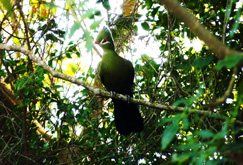Bigger Cape World Heritage Site is on cards
20 May 2015
The Afromontane forests of the Southern Cape, most of them part of the Garden
Route National Park, are up for a listing on the World Heritage List. The list is
compiled by Unesco, the UN Educational, Scientific and Cultural Organisation.
The International Union for Conservation of Nature received a nomination in March
2014 to double the existing World Heritage site. The current site is 557 584 hectares
and includes Table Mountain National Park, Agulhas complex, Langeberg complex
and the Garden Route complex.
If approved, the extended site will include the Wilderness area, state forests and
mountain catchment areas which form a chunk of the Garden Route National Park,
an open access reserve spanning more than 155 000 hectares from Wilderness to
Tsitsikamma.
According to Jill Bunding-Venter, the park's general manager, at least 119
recognised fynbos vegetation types will be added to the existing site of both
endemic
and/or threatened fynbos species.
Green Flag trails
Meanwhile, two hiking trails in the Knysna forest, which is also part of the Garden
Route National Park, have received Green Flag status. Perdekop, a 9.5km nature
walk, and Olifants, in Diepwalle, hiking trails were accredited by the Hiking
Organisation of Southern Africa earlier this month.
The Green Flag a global benchmark for hiking trails and criteria include
conservation status, health and safety measures, cleanliness and maintenance,
sustainability, management and others.
This comes a few days before the world marks International Day for Biological
Diversity, or International Biodiversity Day, celebrated each year on 22 May. It was
proclaimed by the UN General Assembly in 2000 to increase understanding and
awareness of biodiversity issues.
According to the UN, this year's theme, Biodiversity for Sustainable Development,
reflects the importance of efforts made at all
levels to establish a set of Sustainable
Development Goals (SDGs) as part of the UN's Post-2015 Development Agenda for
the period of 2015-2030, and the relevance of biodiversity for the achievement of
sustainable development.
Biodiversity can refer to genetic variation, species variation, or ecosystem variation
within an area. The Cape Floral Kingdom is one of six globally recognised plant
kingdoms. It is the smallest of all six kingdoms and is rich in biodiversity with 8 700
plant species and high endemism: 68% of its plant species are confined to this
kingdom that is just 90 000km2 in size.
The kingdom consists of the five biomes, namely: fynbos, renosterveld, succulent
karoo, sub-tropical thicket and afromontane forest. Fynbos is the dominant
vegetation, and 80% of the kingdom consists of fynbos.
The megadiverse countries are a group of countries that harbour the majority of
Earth's species and are considered extremely biodiverse.
Conservation International
identified 17 megadiverse countries in 1998. All are located in, or partially in,
tropical or subtropical regions. South Africa is ranked third after Brazil and
Indonesia in terms of plant diversity.
SAinfo reporter
 A Knysna turaco, known in South Africa as the Knysna lourie, in Knysna. (image: David Siu, Wikimedia Commons)
A Knysna turaco, known in South Africa as the Knysna lourie, in Knysna. (image: David Siu, Wikimedia Commons)









